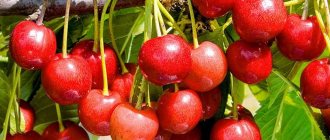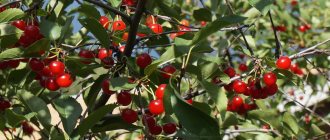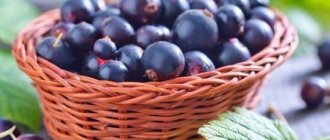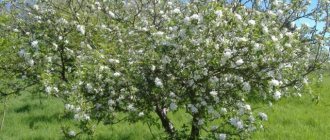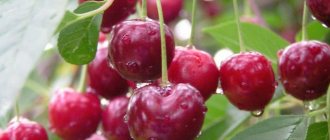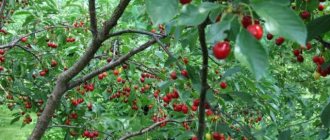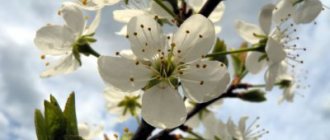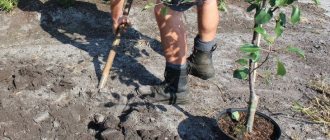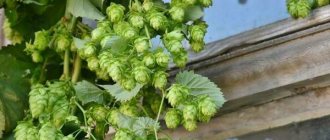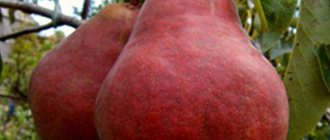Photo and description of the Daibera cherry variety
The tree appeared in 1862 as a result of accidental pollination and was first described by A. Daiber. The plant has been included in the State Register since 1947. Unlike other varieties, the Daibera variety has an impressive size. The crown, resembling a wide oval in shape, is dotted with foliage. The leaves are elongated oval with a pointed tip. The shoots are long, straight, and the bark is brown with a greenish tint. The inflorescence consists of 2–3 flowers, each of which is about 3.5 cm in diameter.
The fruits are large, weighing 6–7 g, and broadly heart-shaped. The skin is smooth and glossy. The color is dark red, almost black. The dense red core with white veins is moderately juicy. The peduncle is wide and thick. Medium sized bone. The fruits are sweet with a slightly noticeable sourness.
Mature tree height
The Daibera variety is one of the tallest types of fruit tree. At the end of the period of active growth, the height reaches 5–6 m.
Flowering and ripening period
Unlike numerous new varieties that begin to bear fruit almost immediately after planting, Daibera cherries produce their first berries only at the age of 5 years. The tree blooms in mid-April. Depending on the prevailing climatic conditions, Daibera cherries ripen in late June–early July.
Productivity
Subject to a combination of careful systematic care and suitable weather conditions, about 90 kg of fruit can be harvested from one mature tree. The largest harvest that was recorded was 170 kg of berries.
Transportability
Due to their dense structure and moderate juiciness, the berries tolerate transportation well over long distances.
Drought resistance
Daibera cherries do not respond well to prolonged drought - due to insufficient moisture, the yield decreases, and the set berries crack and quickly deteriorate.
Frost resistance
The frost resistance of Daibera trees is average. In the northern regions, where the temperature often drops below -20° C, the shoots and flower buds freeze, so it is better to grow the chokeberry variety in the central and southern parts of the country.
Harvest and storage
It is preferable to pick cherries on a fine day in the morning. During this period, the fruit pulp has maximum density. When the harvest is rich, the berries are scattered on a cloth spread in one layer. This allows you not only to sort them comfortably, but also to avoid the pressure of some berries on others. Berries should be removed from the branches only together with the stalk, the nutrients and moisture of which can keep the berries in good condition longer.
The stalks prevent painful microflora from penetrating into the cherries. It is always the berries without stems that spoil first.
Different storage conditions and methods determine the shelf life of berries:
- the berries are stored in the common chamber of the refrigerator for several days;
- Cherries can be stored in the freezer for up to 8 months;
- dried berries are stored for up to 1 year;
- Canned cherries can be stored for 1 year.
Important! Before storing berries, they should not be washed.
The ancient black cherry variety Daibera, and more than a century and a half after its creation, successfully competes with many newfangled modern varieties. The excellent gastronomic qualities of the variety, coupled with its high yield, encourage many gardeners to grow these wonderful cherries in their gardens.
How to plant Daibera cherries
The process of planting black cherries is quite simple. It is important to adhere to this plan:
- In a place protected from drafts and fertilized in the fall, dig a hole 60x60 cm.
- Fill the hole 1/3 full with a mixture of rotted manure and fertile soil.
- Pour a bucket of infertile soil on top of the mound.
- The cherry rhizome is kept in water for 12 hours and then dipped in thick clay mash.
- Stepping back a little from the center, a tall peg is driven into the bottom of the hole.
- A seedling is placed at the top of the mound, the roots are spread out to the sides and covered with soil up to the root collar.
- The soil around the tree is compacted and the trunk is tied to the support with elastic twine.
- The tree trunk circle is protected with a roller of soil.
- 2 buckets of water are added under the seedling, and then mulched with sawdust and peat.
How to choose a seedling
Whether all the efforts spent on planting will go to waste depends directly on the quality of the tree. Despite the fact that it is preferable to plant cherries in the spring, experienced gardeners recommend buying seedlings in the fall. It is at this time that fresh and high-quality planting material is put on the shelves.
When choosing a cherry seedling you need to pay attention to:
- The height of the cherry tree. The length of a one-year-old tree should be 70–80 cm, and a two-year-old tree should be 1 m.
- Root system. The shoots must be free of mechanical damage and areas of rot.
- Place of vaccination. The norm is if the section of the trunk where the scion has taken root is almost imperceptible, dry and without damage.
- Koru. It should be elastic, evenly colored, without peeling, scratches or chips.
Planting dates and scheme
It is recommended to plant cherries in early spring, when the ground has completely thawed and the buds are just beginning to swell. There is no need to rush or put off planting for a long time - the tree will often get sick or, in general, will not take root. During the warm months, the seedlings form a powerful root system and tolerate the winter well.
It is not advisable to plant cherries in the fall. Due to severe frosts, young heat-loving shoots freeze and die. Harsh winters are especially dangerous for annual trees with large growth.
Since the Daibera cherry is a tall, large tree, the distance to another tree should be at least 3 m. The distance between rows is 5 m.
Pit preparation
Before you start digging a hole for planting cherries, you first need to prepare the soil on the site. So in the fall, when digging up 1 sq. m of area, add 150–200 g of saltpeter or 8–10 kg of humus. River sand is added to heavy clay soils, and clay is added to sandy soils. To reduce the acidity of the soil, add lime at the rate of 400–500 g per 1 sq. m. beds.
Before planting, dig a hole in the shape of a cylinder, the depth and width of which is 60 cm. Please note, when digging a hole, the soil from the upper layers must be folded in one direction, and from the lower ones in the other. This is done in order to use fertile soil in filling the hole. After that, stepping back a little from the center, they drive in a long wooden peg, which in the next few years will serve as a support for the young cherry tree.
A bucket of a mixture of fertile soil and humus is poured into the bottom of the planting hole in the form of a mound, with the addition of 100–120 g of superphosphate and 50–60 g of potassium sulfate. The mound-shaped embankment should fill a third of the height of the pit.
Distinctive features
Among the advantages of Daibera cherries, it can be noted that the fruits are 6 grams on average. The berries can be picked in mid-summer. The tree produces high yields, but requires additional pollination for this, since it itself is not pollinated. The downside of the variety is that it has poor disease resistance.
This plant has certain nuances that must be observed when planting. It is recommended to prepare for this procedure in advance by choosing a healthy seedling. On the site at the landing site, it is necessary to prepare and form the soil. The rapid growth of the tree, as well as the presence of large fruits, depends on this. Planting is carried out in the spring, when there is no longer frost, otherwise the seedling will freeze. If the cutting was purchased in the fall, then it must be buried and planting should be postponed until spring.
To get a large harvest, it is recommended to fertilize the soil before planting the seedling. It is also recommended to place a certain amount of fertilizer in the hole itself when planting. In the fall, the area where cherries will grow in the future must be dug up after adding superphosphate or humus to the soil.
The dosage must be selected in each specific case individually based on the manufacturer’s recommendations, as well as conditions in the region.
To get a good harvest and quick survival of seedlings, you need to choose them correctly. Recommended this spring. In this case, it is possible to get the healthiest and highest quality specimen possible.
When choosing, you need to pay attention to the following points:
- the height of the seedling should not exceed 1 m;
- there should be no cracks or damage on the barrel.
Disembarkation stages:
- A hole measuring 50 by 50 cm is dug.
- Manure mixed with black soil is added to the pit. You can also add potassium or superphosphate 300 grams each. All this is poured into the hole at the bottom.
- Next, the beneficial nutritional composition is covered with regular soil so that the roots do not come into direct contact with the fertilizer.
- Before planting, the seedling must be soaked for 12 hours. A peg is driven into the center of the hole, to which the tree is then tied so that it does not break in the wind.
- The root system of the seedling is placed in a hole and sprinkled with earth. Then everything is compacted.
- It is recommended to make a roller around the trunk, which will help retain moisture in the circle around the trunk.
- Then you need to pour two buckets of water under the tree and mulch the ground with sawdust or peat.
Caring for Daibera cherries
No matter how excellent the characteristic, the tree will not be able to justify it without proper supervision. In order for cherries to develop normally and delight you with fruits every year, care must be systematic.
Feeding and watering
Since cherries like to grow in nutritious soil, the tree needs to be fertilized regularly. If this is not done, the berries will be less sweet. Plant feeding scheme:
- April. The ground around the trunk is sprinkled with urea - 200 g per 1 tree.
- June. Before fruiting, slurry (1:6 with water) is applied under the cherries, to which 15 g of complex mineral fertilizer is added.
- Late July–early August. To improve winter hardiness, after harvesting, add 300 g of superphosphate and 100 g of potassium sulfate to the tree trunk circle.
In normal years, when hot weather alternates with rain, cherries are moistened once a month. During drought, the frequency of watering is increased to once a week.
Weeding and loosening
Weeds are not the best neighbors for any cultivated plant, even for such a tall one as the Daibera cherry. Weeding is carried out as pests appear, combining it with loosening the soil. A tree whose roots receive a lot of oxygen suffers less from rot and bears fruit better.
Crown formation
To control the growth of the tree, pruning is carried out before active sap flow begins. Remove diseased, damaged and frozen shoots, and then begin shaping. The tree is pruned in such a way that there are 2 tiers: 7–9 branches are left in the first, 2–3 branches are left in the second. In order to stop the upward growth of cherries and strengthen the side shoots, the central conductor is cut at a height of 3–3.6 m.
Important! To make the cut sites heal faster, wounds with a diameter greater than 1 cm are covered with garden pitch.
Pollinators of Daibera cherry
The Daibera cherry is self-sterile - it cannot pollinate on its own. In order for fruit to set on the site, it is necessary to plant several plants of other varieties. The best pollinators are specimens of the Zhabule, Black Eagle, Golden, Early Olive, Francis, and Hedelfingen varieties.
Rules for planting cherry seedlings
This variety is recommended for cultivation in steppe and forest-steppe zones. The information below describes in more detail the rules for planting Full House cherries.
Optimal timing
It is recommended to plant cherries, even winter-hardy ones, at above-zero temperatures in early spring before the buds swell. Autumn planting can cause freezing and death of the seedling.
Selecting a location
Cherry is a tree that loves warmth and sun. Therefore, as a place for planting stone fruit crops, it is necessary to choose a well-lit, shadow-free area. The influence of cold winds from the north will be detrimental to the tree.
Did you know? “Dukes” is the name given to crossed cherries and sweet cherries.
Such a hybrid was first bred in the 17th century in Europe, and it was then that it was given the name “duke,” which translated from English means duke .
In no case should there be stagnation of moisture in the soil when growing crops. The soil should be loose, not clayey and well drained. If your site still has more clay soil, mix it with sand.
Process and scheme
The dimensions of the hole, which should be prepared in the fall, are as follows: depth - 70 cm, diameter - 1 m.
Next you need to do the following:
- Pour 3 buckets of humus into the soil or pour in 1 liter of wood ash. To reduce soil acidity, it is recommended to add crushed limestone (2-3 buckets).
- The roots of the seedling, soaked in water for 8 hours, must be placed in the hole, not reaching the bottom by 4-5 cm. Carefully cover the roots with soil, make a ditch around the hole, and water generously.
- The distance between several cherry seedlings should be at least 4-5 m.
Diseases and pests of Daibera cherries
The tree does not have high immunity to fungal diseases. Even under normal weather conditions, Daibera cherries are susceptible to coccomycosis, clasterosporiosis, and moniliosis. The plant also suffers from brown spot, scab, and fruit rot. In rainy years, the likelihood of developing these and other fungal diseases increases threefold.
Among the insects, cherries are attacked by the cherry fly, weevil, ringed silkworm, and cherry slimy sawfly. These pests damage buds, leaves and fruits, thereby worsening the general condition of the tree and reducing productivity.
What ails Daibera, problem solving
Low disease resistance is perhaps the main drawback of the variety. Daibera cherry trees are prone to diseases of both viral and fungal nature. The main ones are leaf spot, fruit rot, scab, gum disease, coccomycosis and moniliosis. Cold and rainy weather is especially dangerous.
To prevent infection, you should burn all plant residues in a timely manner, and after leaf fall, treat the trees with conventional fungicides (for example, Bordeaux mixture). Spraying is also carried out in the spring (before the buds swell).
Among the pests, this cherry is especially often attacked by the cherry fly, weevil, and slimy sawfly. They can be combated using any insecticides approved for use in gardens (Decis, Karate, Actellik, etc.).
Video: caring for cherries
Processing Daibera cherries in spring
In spring, when it often rains, protection against fungal diseases is important for cherries.
- In order to prevent the development of fungus, the tree is sprayed with copper-containing preparations during the appearance of buds and after the start of flowering. To prepare the working fluid, add 100 g of the selected product to a bucket of water.
- To scare away cherry aphids from the cherry orchard, the trees are sprayed with an infusion of garlic, onion, dandelion to which 2 tbsp is added. l. soap
- When gum appears, the sticky mass is cut off from the cherry, and the cut area is treated with oil paint and garden varnish.
Advantages and disadvantages
Experienced summer residents speak highly of Daibera cherries and note the following advantages of this crop:
- high productivity;
- the berries retain their presentation for a long time, have high taste, and are stored well;
- the fruits ripen together, so picking them is very convenient;
- Cherry blossoms beautifully, so it will look impressive in landscape design.
However, it should be noted that all the advantages of the variety described above are relevant only if the plant is grown in a region suitable for it, on fertile soil rich in nutrients.
Along with the important advantages of the variety, gardeners also note the disadvantages of Daibera cherries. Here are the main ones:
- berries are often affected by fungus, and leaves by viruses;
- due to the bright color and sweet taste of the fruits, this variety is especially attractive to thrushes and, if you do not worry about saving it, you can easily lose most of the berries;
- the plant does not tolerate drought and frost;
- The tree has a dense branched crown, so frequent pruning is required.
Another disadvantage is that cherries need to be fed at least 4 times per season, while other varieties usually need 2-3 feedings.
Daibera cherry is an old, time-tested variety. If you properly care for the tree, it will certainly give a good harvest and decorate any orchard.
https://agronomu.com/bok/575-daybera-chernaya-samye-primechatelnye-osobennosti-sorta-a-takzhe-sovety-po-uhodu-i-posadke.htmlhttps://fermilon.ru/sad-i- ogorod/derevya/chereshnya-dajbera-chernaya.htmlhttps://7ogorod.ru/plodovye-derevya/ceresna-dajbera.html
Agricultural technology for growing "Dibera"
In general terms, this is a fairly unpretentious fruit tree. If all the rules are followed during planting and fertilizing is done, then worries about the plant will be reduced to a minimum. It is imperative to monitor the soil moisture around the tree during the hot season.
Along with watering, the tree requires three feedings during the season, and pruning must be done annually.
As a top dressing for Daibera in April, 0.2-0.3 kg of urea is added to loosen the tree trunk circle.
The next feeding is done after fruiting is completed. The composition of this fertilizer is potassium sulfate – 0.15 kg and superphosphate – 0.3 kg.
The last feeding is before wintering. On each trunk circle, 20 kg of humus is mixed with the soil under the tree and watered with plenty of water.
History of the variety
This variety of cherry was not specially bred, but appeared due to accidental pollination. The homeland of the black cherry variety Daibera is Crimea. The official date of birth of the culture is considered to be 1862. The culture was named after the gardener who first discovered the variety and compiled its detailed description. This variety of cherries was included in the State Register after the war in the late 1940s.
Cherries were zoned in the North Caucasus and in the Lower Volga region. The official name of the variety is A. Daibera Black cherry, but people often use the abbreviated names Daibera, Black. Sometimes this variety is called Crimean cherry.
